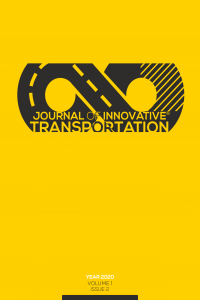Abstract
References
- Bayata, H. F., & Bayrak, O. Ü. (2018). Yeni Yapılması Planlanan bir Kavşağın Mikro-Simülasyon ile Değerlendirilmesi. Erzincan Üniversitesi Fen Bilimleri Enstitüsü Dergisi, 11(3), 550-559. https://doi.org/10.18185/erzifbed.441327
- Park, B., & Schneeberger, J. D. (2003). Microscopic simulation model calibration and validation: case study of VISSIM simulation model for a coordinated actuated signal system. Transportation Research Record, 1856(1), 185-192. https://doi.org/10.3141%2F1856-20
- Siddharth, S. M. P., & Ramadurai, G. (2013). Calibration of VISSIM for Indian heterogeneous traffic conditions. Procedia-Social and Behavioral Sciences, 104(0), 380-389. https://doi.org/10.1016/j.sbspro.2013.11.131
- Keçeci, A. (2006). Türkiye’de karayolu taşımacılığı. Uluslararası Ekonomik Sorunlar Dergisi, 20.
- Selimoğlu, E. (2014). Trafik Kazalarının Nedenleri, Sonuçları ve Kazaların Önlenmesine İlişkin Öneriler. Ziraat Mühendisliği, (361), 51-54.
- Singh, S. (2015). Critical reasons for crashes investigated in the national motor vehicle crash causation survey (No. DOT HS 812 115).
- Yılmaz, E. (2000). Karayolu Geometrik Standartları ile Karayolu Güvenliği ve Kapasitesi İlişkileri (Doctoral dissertation) Fen Bilimleri Enstitüsü, Istanbul Technical University, Turkey.
- Aydın, M. M., Yıldırım, M. S., Saplıoğlu, M., & Ünal, A. (2017). Şehiriçi Yollardaki Geometri Problemlerinin Sınıflandırılması ve Çözüm Önerileri Geliştirilmesi, International Academic Research Congress.
- Türkiye İstatistik Kurumu (TUİK), (2016). Trafik Kaza İstatistikleri, Ankara. Retrieved from https://data.tuik.gov.tr/Kategori/GetKategori?p=ulastirma-ve-haberlesme-112&dil=1
- Felez, J., Vera, C., & Martı́nez, M. L. (1998). Virtual reality applied to traffic accident analysis. Computer networks and ISDN systems, 30(20-21), 1907-1914. https://doi.org/10.1016/S0169-7552(98)00181-0
- Yang, X. L., Li, P., Lv, T., & Liao, X. H. (2013). Traffic Accident Reconstruction Technology Research. Advanced Materials Research, 756, 946-951. https://doi.org/10.4028/www.scientific.net/AMR.756-759.946
- ISSD. 2020. VISSIM Mikro Ölçekli Trafik Simulasyonu. Retrieved from https://www.issd.com.tr/tr/18927/PTV-VISSIM-Mikro-Olcekli-Trafik-Simulasyonu
- PTV Group. 2020. PTV VISUM. Retrieved from http://vision-traffic.ptvgroup.com/en-us/products/ptv-visum/
- PTV Group. 2020. VISTRO. Retrieved from https://www.ptvgroup.com/en/solutions/products/ptv-vistro/
- PTV Group. 2020. VISWALK. Retrieved from http://vision-traffic.ptvgroup.com/en-us/products/ptv-viswalk/
- PTV Group. 2020. OPTIMA. Retrieved from http://vision-traffic.ptvgroup.com/en-us/products/ptv-optima/
- Autodesk. 2020. INFRAWORKS. Retrieved from https://www.autodesk.com/products/infraworks/overview
- ANYLOGIC. 2020. AnyLogic Simulation Software. Retrieved from https://www.anylogic.com/
- VIRTUAL CRASH. 2020. Virtual Crash Accident Reconstruction Software. Retrieved from https://www.vcrashusa.com/vc4
Analysis of highway geometric design and effect of speed factor on traffic accidents with virtual reality program
Abstract
Highway geometry plays an important role in road safety and mobility. A successful or unsuccessful geometric design result directly or indirectly affects the driver, the physical implementation of the design. Therefore, roads should be designed with the driver in mind. Virtual reality programs play an important role in helping road engineers design and evaluate alternative road configurations. Virtual reality programs play an important role in evaluating the geometric design security of roads, intersections of roads and intersections and taking precautions against problematic geometric elements. In this study, the importance of geometric standards in existing highways is confirmed by using Virtual CRASH4, a virtual reality program. In this context, three highways with different design criteria were designed using Virtual CRASH4. Accident risks arising from speed changes and design errors have been identified on the designed roads.
References
- Bayata, H. F., & Bayrak, O. Ü. (2018). Yeni Yapılması Planlanan bir Kavşağın Mikro-Simülasyon ile Değerlendirilmesi. Erzincan Üniversitesi Fen Bilimleri Enstitüsü Dergisi, 11(3), 550-559. https://doi.org/10.18185/erzifbed.441327
- Park, B., & Schneeberger, J. D. (2003). Microscopic simulation model calibration and validation: case study of VISSIM simulation model for a coordinated actuated signal system. Transportation Research Record, 1856(1), 185-192. https://doi.org/10.3141%2F1856-20
- Siddharth, S. M. P., & Ramadurai, G. (2013). Calibration of VISSIM for Indian heterogeneous traffic conditions. Procedia-Social and Behavioral Sciences, 104(0), 380-389. https://doi.org/10.1016/j.sbspro.2013.11.131
- Keçeci, A. (2006). Türkiye’de karayolu taşımacılığı. Uluslararası Ekonomik Sorunlar Dergisi, 20.
- Selimoğlu, E. (2014). Trafik Kazalarının Nedenleri, Sonuçları ve Kazaların Önlenmesine İlişkin Öneriler. Ziraat Mühendisliği, (361), 51-54.
- Singh, S. (2015). Critical reasons for crashes investigated in the national motor vehicle crash causation survey (No. DOT HS 812 115).
- Yılmaz, E. (2000). Karayolu Geometrik Standartları ile Karayolu Güvenliği ve Kapasitesi İlişkileri (Doctoral dissertation) Fen Bilimleri Enstitüsü, Istanbul Technical University, Turkey.
- Aydın, M. M., Yıldırım, M. S., Saplıoğlu, M., & Ünal, A. (2017). Şehiriçi Yollardaki Geometri Problemlerinin Sınıflandırılması ve Çözüm Önerileri Geliştirilmesi, International Academic Research Congress.
- Türkiye İstatistik Kurumu (TUİK), (2016). Trafik Kaza İstatistikleri, Ankara. Retrieved from https://data.tuik.gov.tr/Kategori/GetKategori?p=ulastirma-ve-haberlesme-112&dil=1
- Felez, J., Vera, C., & Martı́nez, M. L. (1998). Virtual reality applied to traffic accident analysis. Computer networks and ISDN systems, 30(20-21), 1907-1914. https://doi.org/10.1016/S0169-7552(98)00181-0
- Yang, X. L., Li, P., Lv, T., & Liao, X. H. (2013). Traffic Accident Reconstruction Technology Research. Advanced Materials Research, 756, 946-951. https://doi.org/10.4028/www.scientific.net/AMR.756-759.946
- ISSD. 2020. VISSIM Mikro Ölçekli Trafik Simulasyonu. Retrieved from https://www.issd.com.tr/tr/18927/PTV-VISSIM-Mikro-Olcekli-Trafik-Simulasyonu
- PTV Group. 2020. PTV VISUM. Retrieved from http://vision-traffic.ptvgroup.com/en-us/products/ptv-visum/
- PTV Group. 2020. VISTRO. Retrieved from https://www.ptvgroup.com/en/solutions/products/ptv-vistro/
- PTV Group. 2020. VISWALK. Retrieved from http://vision-traffic.ptvgroup.com/en-us/products/ptv-viswalk/
- PTV Group. 2020. OPTIMA. Retrieved from http://vision-traffic.ptvgroup.com/en-us/products/ptv-optima/
- Autodesk. 2020. INFRAWORKS. Retrieved from https://www.autodesk.com/products/infraworks/overview
- ANYLOGIC. 2020. AnyLogic Simulation Software. Retrieved from https://www.anylogic.com/
- VIRTUAL CRASH. 2020. Virtual Crash Accident Reconstruction Software. Retrieved from https://www.vcrashusa.com/vc4
Details
| Primary Language | English |
|---|---|
| Subjects | Transportation Engineering |
| Journal Section | Research Articles |
| Authors | |
| Publication Date | December 31, 2020 |
| Submission Date | November 25, 2020 |
| Acceptance Date | December 6, 2020 |
| Published in Issue | Year 2020 Volume: 1 Issue: 2 |


